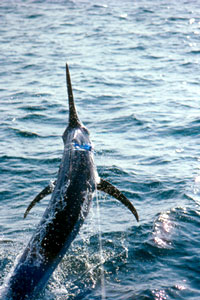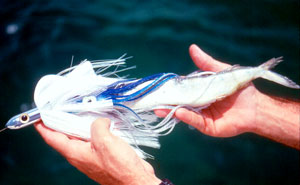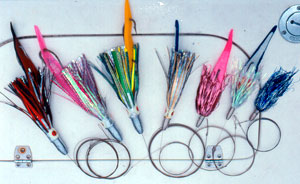How many times have you been trolling without so much as a strike, only to hear a VHF report from someone who's into fish just a few miles away? It happens all the time, but surprisingly few trollers bother to do much about it. They often rationalize their decision to stay put by saying that it's too much trouble to retrieve the baits, that the baits will tear apart if trolled faster, or that they wouldn't be able to get there fast enough anyway.
Most of the time they'll simply turn their boat toward the scene of activity and continue trolling along at the same speed. If and when they finally arrive, the fish have either moved on stopped feeding.

On the other hand, it often makes sense to keep your baits in the water. Unless an area is completely devoid of fish sign (e.g., bait, flotsam, rips, etc.), I do not like to retrieve my trolling baits and roar off to another spot. By doing so I could miss out on a golden opportunity. Therefore, I usually take a gamble and keep on trolling my way toward the hot zone, albeit at a faster clip. This strategy continues to uncover plenty of action along the way, and during those dreadfully slow days it has frequently resulted in a trophy fish such as a big solitary dolphin, marlin, tuna or wahoo.
It's The Fish - Stupid!
Search-pattern trolling is an art unto itself. Unlike conventional trolling tactics and speeds aimed at targeting game fish in the immediate area, the technique really shines when strikes are few and far between, or when you're chasing birds or fish on the move. It lets you expand your search by trolling faster and covering more water. Therefore, the odds of coming across a hungry fish or an active zone increase. When such a zone is uncovered, a normal trolling strategy can be resumed within minutes.
The math is simple: More territory can be covered by trolling at faster speeds. The challenging part is adjusting your bait spread to withstand the increase in drag. Natural baits are susceptible to washing out or tearing at aggressive trolling speeds. While a perfectly orchestrated spread of natural baits may look appealing at ten knots, they usually begin skipping, flipping, slapping or disintegrating when the speed is increased to around 15 knots.
Natural-bait advocates who are attempting to chase birds or moving fish in close proximity to the boat can simply drop their baits farther back as they increase speed. If the baits continue slapping or skipping, more line should be let out until they track properly. Upon reaching the fish a more conventional trolling speed should be resumed, and the baits reeled back to their normal positions. Although lures are generally trolled faster than natural baits, thereby allowing you to cover more territory, the same advice should be followed if they begin skipping at higher speeds.

The Next Level
Searching small areas or chasing fish in close proximity requires the least amount of adjustments. However, extensive search-pattern trolling demands more modifications. For instance, natural baits must be prepared to withstand the rigors of trolling for long periods at higher-than-normal speeds, which can be a tough feat! By slipping a plastic trolling skirt over each bait, for example, you can often prevent them from washing out prematurely. That's because the skirt deflects water over the bait's head, minimizing drag.
Disadvantages of plastic skirts for long-distance, high-speed trolling include their lack of weight (to keep the bait under the water) and limited protection (they don't shield the entire body). A better adjustment for long-range searches is to rig a lure or lure head in front of each trolling bait. The lure head punches a larger "hole" through the ocean, thereby deflecting water around a larger portion of the bait. The larger the diameter and the blunter the head, the broader the deflection zone. The lure's additional weight and design should also help keep it in the water at high speeds.
Blunt- or straight-cut lure heads troll best at speeds of between eight and 15 knots. When a faster trolling speed is required, simply tighten the outrigger clips' tension setting and drop the baits back until they're churning and "smoking" through the water. When a more traditional trolling speed is resumed, remember to loosen the tension on the outrigger clips.
Combining Speed and Depth
Dart- or jethead-style lures and Octopus skirts with sinker inserts are favorites among anglers who make high-speed, search-trolling missions for wahoo and tuna. The lighter, pointier heads of these lures continue to track beneath the surface when pulled at speeds of between ten and 15 knots, yet also perform well at more traditional speeds. Then there are the heavily weighted designs for super-fast, subsurface fishing at speeds of between 15 and 20 knots.
One of the hottest offshore tools on the market, and one that seems custom-made for dart and jethead lures, is the high-speed planer. This deadly device fishes a bait several feet beneath the surface at conventional trolling speeds. However, unlike a traditional planer it can also be fished at speeds approaching 18 knots. Trolling wire line in conjunction with a one pound sinker and a heavy, streamlined lure also works well for high-speed trolling.
Other fine-tuning tips for fast trolling include attaching the flat lines to transom clips, as well as setting the outrigger clips at the mid-pole position. Both tactics help reduce the angle at which the lines enter the water. The more parallel the lines are to the water, the better the baits will perform at higher speeds.
Radical Tactics
If fishing's really tough, or when traveling to and from the grounds, try trolling a pair of 16-ounce dart or jethead lures from the flat lines. This is a popular method among tuna anglers who routinely follow working birds or want to cover a large expanse of water.

I have a friend who often trolls his way back to Florida after visiting Bimini, a 55-mile journey. He deploys a single wire-line outfit with a 16-ounce tuna dart rigged with No. 12 wire, dual 10/0 hooks (Mustad 3412C lead hook, Mustad 3407SS rear hook) and a plastic bonito belly strip bait. Positioning that bait far back, he's able to fish while cruising at a respectable 20 knots. The weight of the wire line and lure, and the distance it's trolled behind the boat, keep the rig in the water, where it occasionally scores big dolphin and wahoo. His most recent impressive "troll home" catch was a 110-pound yellowfin tuna!
This radical tactic calls for an upgrade in tackle. Wire leaders are the norm, since wahoo are strong possibilities. And since the weight of the lures and the speed at which they're trolled will kink lighter leaders, the outfits should be rigged with 15 feet of No. 12 (275-pound test) to No. 15 (278-pound test) wire. The lures are always fished "as is" or with a plastic strip bait (using a natural bait won't cut it). Curved-butt rods, although not essential, will also help keep the line more parallel to the water.
The next time fish become difficult to find, don't waste time pondering whether to pick up and run or just continue plodding along. Try experimenting with your bait spread and burning a little more fuel. The rewards could be impressive.

